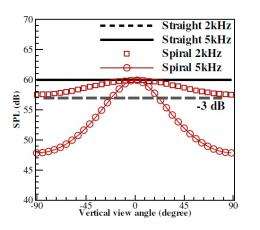June 14, 2012 feature
Engineers investigate why the cochlea is coiled

(Phys.org) -- The word “cochlea” comes from the Latin for “snail shell.” While this inner ear component has a clear spiral shape, it’s currently unclear why that is. In the 1980s, scientists supposed that the shape evolved solely for space conservation, but in the past few years researchers have questioned this view and proposed that the spiral curvature could have perceptual benefits as well. In a recent study, a team of engineers has added evidence to this view by performing simulations showing that a coiled cochlea can detect the source of a sound in the vertical direction significantly better than a straight cochlea.
The researchers, Xun Huang, Chi Xu, and Long Bai, at Peking University in Beijing, China, have published their study on the coiled cochlea’s ability to provide vertical sound localization in a recent issue of EPL.
The idea that the cochlea’s spiral shape has perceptual benefits is somewhat surprising, since currently most cochlear models used in research simplify the cochlea as a straight system. This simplification seems justified because numerical simulations have shown that a straight cochlea and coiled cochlea have a similar mechanical oscillation amplitude, which describe the vibrations that get sent to the brain. However, recent research has suggested that there may be significant differences in the way that straight and coiled cochlea respond to sound.
“One previous paper stated that the spiral’s graded curvature enhances the cochlea’s mechanical response to low frequencies,” Huang told Phys.org. “Our work is the first one in sound localization. Basically, most previous works focus on ‘low level’ functions, such as mechanical response. We show that sound localization may be one of the potential functions of the cochlea’s coiled geometry, which was assumed solely developed for saving space.”
As all individuals with good hearing can attest, the ears can detect the source of a sound in both the horizontal and vertical planes. Horizontally, a sound source produces a time and volume difference between the left and right ears because the ears have different horizontal positions. But since the left and right ears are positioned at the same height on the head, a sound source in the sagittal plane (the vertical plane that divides the body into left and right halves) produces no difference between the two ears based on the source’s vertical position. Instead, two parts of the ear called the pinna and tragus help mammals achieve vertical sound localization.
However, recent experiments with the brown bat (Eptesicus fuscus) have suggested the existence of an alternative mechanism for vertical sound localization. After researchers disabled the function of the bat’s tragus, its vertical sound localization capability was weakened, but only temporarily. After a period of adaptation, the capability was partially restored due to an alternative mechanism.
As the researchers show here, one potential alternative way of achieving vertical sound localization could be the coiled shape of the cochlea. To begin, they proposed that the human hearing system might adopt a method similar to adaptive beamforming, a technique used for directional signal processing, to process sound signals for the brain. In their simulations, the researchers modeled the thousands of hair cells in the 3.5-cm-long cochlea as a sensor array in the context of beamforming. Then they compared how this sensor array perceived sound pressure when arranged in a straight vs. spiral geometry.
Their results revealed that straight and spiral cochleas generate different beam patterns, i.e., acoustic images of the sound sources. For all sound sources, the straight cochlea generates a beam pattern that spans the entire vertical range, providing no vertical sound localization. In contrast, the coiled cochlea generates different and much narrower beam patterns for different sound sources, providing significantly improved vertical sound localization. For horizontal sound localization, the straight and coiled cochleas show comparable performance.
Discover the latest in science, tech, and space with over 100,000 subscribers who rely on Phys.org for daily insights. Sign up for our free newsletter and get updates on breakthroughs, innovations, and research that matter—daily or weekly.
The finding that vertical sound localization can be improved purely by geometric changes supports the argument that the cochlea’s coiled shape is useful not just for conserving space. The results could be helpful for designing cochlear implants and echolocation systems, in which sound waves are used to detect objects.
“From the very beginning, we were actually studying bat flight control based on sound echolocation,” Huang said. “As you can see, vertical sound localization is very important for bat flight. However, the biological information of a bat’s cochlea is not so accessible. Hence, we used the human cochlea as a test case.”
Huang added that they are currently designing experiments in an anechoic chamber to test the results of these simulations.
More information: Xun Huang, et al. “Is the cochlea coiled to provide sound localization?” EPL, 98 (2012) 58002. DOI: 10.1209/0295-5075/98/58002
Copyright 2012 Phys.org
All rights reserved. This material may not be published, broadcast, rewritten or redistributed in whole or part without the express written permission of PhysOrg.com.


















